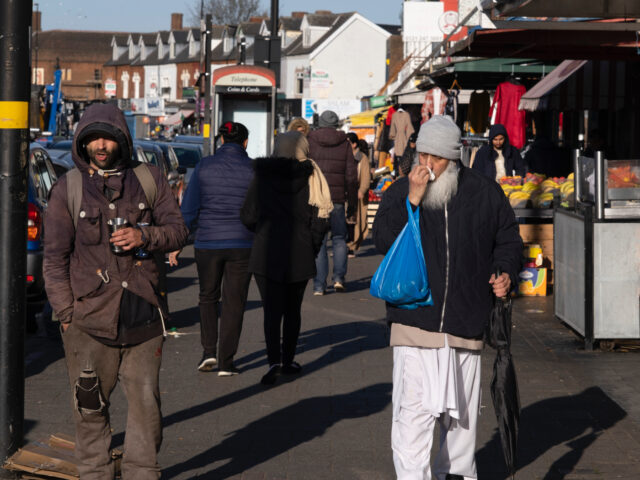Britain’s second-largest city Birmingham and the multicultural hub of Leicester have joined the ranks of minority-majority cities in England, according to last year’s census results.
Figures from the once-in-a-decade census showed that 59.1 per cent of people living in Leicester identify as having an ethnic minority background in 2021, a radical shift from just twenty years ago when 63.9 per cent of people in the East Midlands city identified as white. The shift is even starker when looking at the 1991 Census, which recorded the white population as being 96.6 per cent of inhabitants.
The 2021 Census results have also shown that England’s second-largest city, Birmingham, has recorded a majority in ethnic minorities at 51.4 per cent. The white population in the city has fallen from 71 per cent in 2001 and 58 per cent in 2011 to just 48.6 per cent last year. The 1991 Census — which was the first to ask ethnicity questions and notably the last national record before the mass migration era of Prime Minister Tony Blair — put the white population of Birmingham at 78.5 per cent.
While it is possible to infer some ethnic rates in the 1981 Census through examination of the differing Commonwealth classifications, such as the “Old Commonwealth” (Australia, Canada and New Zealand), “the New Commonwealth” (including India, Pakistan, Bangladesh and the West Indies), and “the African Commonwealth” (including Nigeria, Uganda and Kenya), precise ethnic statistics were not recorded until later, a decision that the Parliament later admitted was a mistake.
Luton has also become a minority-majority city (54.8 per cent), joining London and cities across Europe, including the likes of Frankfurt and Antwerp.
As a whole, the Census found that white people represented 81.7 per cent (48.7 million) of the population of England and Wales, compared to 86 per cent (48.2 million) in the 2011 Census.
When only looking at those white people who identify themselves as being one of the indigenous ethnic groups of the British Isles (English, Welsh, Scottish, Northern Irish or British) the percentage falls to 74.4 per cent (44.4 million) compared to 80 per cent (45.1 million) in 2011, and 87.5 per cent (45.5 million) in 2001.
The next most common ethnic group recorded was among those identifying as either “Asian, Asian British or Asian Welsh,” which comprised 9.3 per cent (5.5 million) of the overall population. This group also held the distinction of seeing the largest increase over the 2011 Census, increasing from 7.5 per cent (4.2 million).
The demographic changes came ahead of the record waves of migration — both illegal and legal — over the past year since the census was actually taken in March 2021, with net migration hitting its highest level in history as former Prime Minister Boris Johnson’s points-based immigration system granted over 1.1 million visas to foreigners over the past year.
In comments provided to Breitbart London, Alp Mehmet, Chairman of Migration Watch UK, said: “These figures paint a stark picture of the way in which very high levels of immigration have – in a short period of time – changed large parts of Britain, without democratic consent. The extraordinary speed with which this demographic transformation has taken place comes not only at considerable economic cost and huge pressure on housing, the NHS and services but also makes integration and societal cohesion so much more difficult, if not impossible.
“With immigration levels at record levels, the government has no choice but to honour its promises to restore control of our borders and cut immigration by a lot.”
Also expressing concern was Brexit leader Nigel Farage, who has become a hawkish figure on England’s growing irregular immigration crisis. Speaking Tuesday, he said: “…massive, massive demographic changes taking place in our country… there is a massive change in the identity of this country that is taking place through immigration.”
Expressing concern about previous suggestions that the way future censuses will be taken, making decade-to-decade trends on comparable datasets harder to illustrate, he continued: “the ONS say in future they will not ask the nationality or birthplace of [respondents]. One-in-six in England and Wales already born outside the UK. In future, they want to hide the true figures from you.”
The legacy media was far more glowing in response to the massive demographic shifts, however, with the BBC speaking to residents in Leicester who “welcomed the news“.
“I feel privileged being in a city that holds so much diversity and inclusivity as well,” a local teacher told the public broadcaster.
Ugandan Asian photographer who moved to the city in the 1970s went on to proclaim that “Leicester is the most harmonious city in all of Europe… I take pride that we helped contribute something.”
Despite the rosy picture painted of the city, which is often hailed as a beacon for the multicultural project, Leicester has been the epicentre of a growing spate of sectarian violence between Hindu and Muslim residents of the city. Following an India vs Pakistan cricket match in August, widespread sectarian violence broke out between the two populations with large groups of young men, often clad in balaclavas and masks, engaging in violence.
Leicester also holds the distinction of being one of the main hubs in Britain for modern-day slavery, with a report from the Centre for Social Justice claiming in 2020 that the city accounted for about 10 per cent of all slave labourers in the country, with some 10,000 slaves recorded as working in the city, which is home to a large fast-fashion textile industry.
The report said that people smuggling networks are believed to be working with local gangsters in order to exploit illegal immigrants from the Middle East and Eastern Europe, who are trapped in “debt bondage” during their journey to enter the UK illegally.
Follow Kurt Zindulka on Twitter here @KurtZindulka

COMMENTS
Please let us know if you're having issues with commenting.